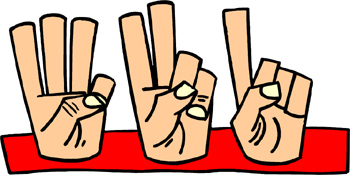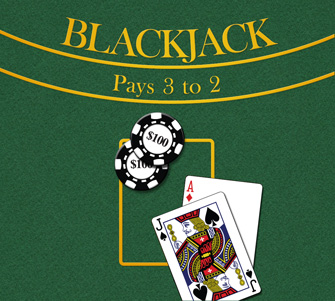Card Counting in Blackjack
Counting Cards - Blackjack Counting
Card counting in blackjack is used to determine when the player has an advantage over the house. This is done by tracking the ratio of high cards to low cards, with more high cards being the desired outcome. Since the objective of blackjack is to get as close as possible to 21, more high cards in the deck means a greater chance of the dealer busting or the player getting a natural. It should be noted, however, that card counting in blackjack is a precise art which requires many hours of practice.
History of Blackjack Counting
 The history of counting cards really got started in 1962 with the publication of Beat the Dealer by Dr. Edward O. Thorp. It quickly became the bible for blackjack counting, and Thorp is still recognized as the father of card counting in blackjack.
The history of counting cards really got started in 1962 with the publication of Beat the Dealer by Dr. Edward O. Thorp. It quickly became the bible for blackjack counting, and Thorp is still recognized as the father of card counting in blackjack.
Many of his strategies for counting cards, however, no longer work, as the casinos took steps to counter them. For example, casinos once dealt to the last card in a deck, but this is no longer the case.
The history of card counting does stretch back beyond 1962, however. Prior to Thorp's book, men like Jess Marcum and Joe Bernstein were successfully using blackjack counting methods to gain an advantage over the casino. And in 1957, Roger Baldwin, Herbert Maisel, James McDermott and Wilbert Canteny (eventually known as "The Four Horsemen") developed a card counting system using only basic mechanical calculators.
Ken Uston became the first to write about the tactics of card counting in a book titled Big Player Team. Released in the 70s, Uston's book detailed his time spent as a member of Al Francesco's card counting team. Uston would later become perhaps the most famous card counter thanks to several more books and numerous television appearances.
As blackjack counting teams became more publicized, numerous card counters decided to get in on the action. Leaders of these teams have included men such as Tommy Hyland, Ken Uston and Al Francesco. Perhaps the most famous, though, was the MIT Blackjack Team, made famous in the Ben Mezrich book Bringing Down the House.
But as strategies and tactics have become more sophisticated for counting cards, the casinos have also turned to advanced methods for identifying such players and banning them. As the history of counting cards continues to develop, the shadow war between casinos and card counters rages on.
Card Counting Explained
The primary myth about card counting that needs to be dispelled is that players are keeping track of specific cards. This is simply not the case. Instead, card counting experts assign a value to each card which they see introduced into play. A card counter does not need to be a mathematics whiz to be successful at the art.
Values usually take the form of +1, -1 or 0. In the Hi Lo system (refined by Stanford Wong and Julian Braun), for example, any card which ranges from 2 to 6 is counted as +1. Cards 7 through 9 are zero, and tens through aces are -1. Each time the card counter sees a card, he adds or subtracts a number based on this information. It should be noted that there are other card counting systems, but the plus-minus system is considered one of the most basic and accurate.
When the current count is positive, the player will want to increase their bet. This is due to the fact that more high cards are left in the deck. When the count is negative, the player will want to lower their bet, as the odds of getting a natural are far less.
If you use a card counting system on an entire 52-card deck and end up with 0, then that system is said to be "balanced." If, on the other hand, the resulting count is greater or less than zero, then the blackjack counting system is said to be "unbalanced."
More advanced blackjack counting systems also exist, and these may assign values such as +2 or -2 to cards in the deck. While many believe that these advanced systems improve the accuracy of card counting, others find the additional numbers to be distracting. Ultimately, someone who is planning on counting cards will need to experiment to find the system which works best for them.
Casino Tactics
Casino tactics to stop card counters are constantly being upgraded and developed. The casino industry has spent a great deal of money over the years to try and thwart the serious card counter, and their efforts continue to this day. While Atlantic City does have restrictions on what kind of countermeasures can be used (such as banning a player), Nevada has no such limitations. Some of these casino tactics include:
- Identifying card counting pros. This might be as simple as a book full of pictures or as advanced as facial recognition software. When professional card counters are spotted, they may immediately be asked to leave the premises. A former blacklist was maintained by Griffin Investigations, but they were driven into bankruptcy in 2005 following a libel lawsuit by gamblers.
- Prohibiting the player from changing the amount of their bet during a shoe.
- Changing the stakes of the table. The casino may also opt to change the rules of the game concerning multiple hands, doubling down and splitting.
- Shuffling more often. The dealer may also shuffle when the player suspected of counting cards increases their bet. Of course, this also means that the other players will receive less hands per hour, so the tactic could ultimately cost the casino money in the long run.
- Harassment. One of the favored casino tactics. This might be as harmless as talking to the player to break their concentration. In some countries, however, this can still take the form of fairly extreme behavior.
- Increasing the number of decks that are being dealt from. The more decks involved, the harder it is to employ blackjack counting.
- Surveillance. Casino employees will watch suspected players with cameras known as the "Eye in the Sky."
- Scanners and software in the blackjack table will scan every card in a shoe. In some cases, this program will even recommend that the dealer reshuffles the deck to negate a possible player advantage.
Profit from Counting Cards
So what's the expected profit from counting cards? Well, a normal player engaged in card counting can expect about a 1% edge over the casino. If playing at a table where the standard bet is $100, then this advantage will translate into $1 per hand. As you can see, making a big profit from counting cards requires patience and persistence, as well as skill.
See also:


 CasinoMax
CasinoMax


